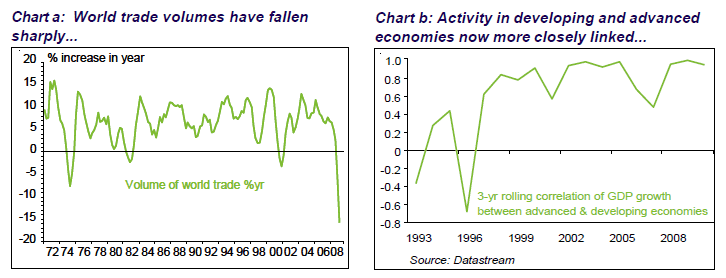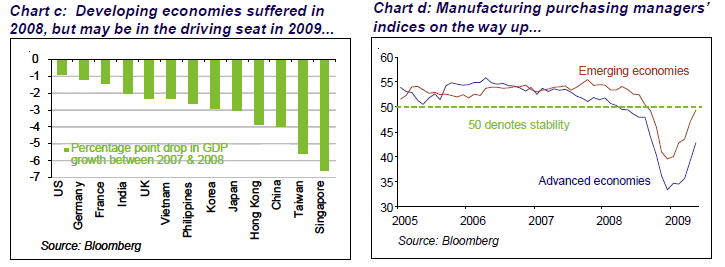Developing Economies Lead the Way Out of Global Recession
Economics / Economic Recovery Aug 03, 2009 - 03:06 AM GMTBy: Lloyds_TSB
 Following the onset of the global credit crisis two years ago, it was generally believed that developing economies, particularly in Asia, would be better placed to weather the storm than some of the more advanced economies, such as the US and UK. It was reasoned that the export-orientated, savings-rich countries, with the support of China, faced little prospect of an external payments crisis and were one step removed from the bursting of the debt bubble created in western economies. De-coupling was the buzzword at that time. Yet, over the subsequent twelve to eighteen months, expectations that the developing world could distance itself from the global credit crisis faded amid a collapse in world trade.
Following the onset of the global credit crisis two years ago, it was generally believed that developing economies, particularly in Asia, would be better placed to weather the storm than some of the more advanced economies, such as the US and UK. It was reasoned that the export-orientated, savings-rich countries, with the support of China, faced little prospect of an external payments crisis and were one step removed from the bursting of the debt bubble created in western economies. De-coupling was the buzzword at that time. Yet, over the subsequent twelve to eighteen months, expectations that the developing world could distance itself from the global credit crisis faded amid a collapse in world trade.
Having risen by an annual average of 8% between 2003 and 2007, world trade volumes dropped by over 15% in 2008 - see chart a. Within the developed world, Germany and Japan bore the brunt of the downturn, with merchandise exports and industrial production in both countries falling sharply in 2008. But many of the newly-industrialising and developing economies, including China, Hong Kong, South Korea and Thailand were also badly affected.
The correlation between developing and advanced economy growth has risen sharply Chart b shows the correlation of GDP growth between developing and advanced economies over the past two decades. Despite earlier expectations of de-coupling, their economic performances have become increasingly intertwined. In the early 1990s, the correlation coefficient was volatile around zero, implying little or no relationship in the average GDP growth rates of the two economic regions. Over the past decade, however, the correlation has risen strongly.
While the high correlation suggests the average GDP growth rates in these two economic regions move in the same direction, it tells us nothing about the magnitude of these movements. Since the credit crisis erupted, not only have developing economies been dragged lower, but in many cases their over-reliance on external trade has left them exposed to far sharper downturns in growth - see chart c. For example, as a group, emerging market GDP dropped by 2.3 percentage points between 2007 and 2008, compared with a drop of 1.6 percentage points for the major advanced economies.
But developing economies have started to outperform in recent months Over recent months, however, the tide appears to have turned. Just as the developing economies took the sharpest knock following the credit crisis, these economies now appear to be bouncing back the fastest – see chart c. The bounce-back is being led by China. In the second quarter, China’s annual rate of growth rose to 7.9% from 6.1%. It was the first acceleration in China’s growth rate in more than two years. Other developed economies also appear to have recovered some poise. For example, Singapore’s GDP grew by an annualised 20.4% in the second quarter, bringing an end to the economy’s worst recession in 45 years. South Korea also posted a robust 2.3% quarter-on-quarter increase in GDP during the second quarter.


How have developing economies managed to bounce back so sharply over recent months?
As in the advanced world, part of the improvement in growth in the developing economies reflects a moderation in the pace of inventory liquidation. More fundamentally, however, it also reflects an improvement in global trade. With the world economy over the worst of the credit crisis, global trade flows appear to have bottomed out. For example, the Baltic Dry Freight Index – an index of shipping costs – has risen more than four-fold since the end of 2008, one of a number of key indicators suggesting that global trade is now starting to turn higher. Since developing economies tend to derive a disproportionate share of their national income from exports, early signs of a recovery in world demand tend to show up first in improvements in developing world GDP.
It is not only inventories and the turn in the world trade cycle, however, that have boosted developing economies in recent months. There are also signs that domestic demand conditions in some of these economies are improving, underpinned by government stimulus – particularly in China. A 4trn yuan ($585bn) stimulus plan is currently being implemented by the Chinese government comprising infrastructure spending, tax cuts and various incentives to induce consumers to buy cars and electronic goods. Apart from the stimulus, the Chinese government is also exerting pressure on banks to lend more. The impact of these measures is clearly evident. Over the first half of this year, Chinese fixed investment spending surged almost 34%, the fastest growth in nearly five years. Over the same period, the annual rate of China’s money supply growth has doubled to 28%. Recovery in developed economies raises hopes for stronger, more balanced growth ahead
There are hopes that the efforts taken by China, and other developing countries, to stimulate their domestic economies will help to support growth prospects elsewhere. If China can successfully wean itself of its dependence on exports, and develop a more efficient, market-based domestic economy, the prospects for China’s economy and, by extension, the world economy, would be that much stronger. For this to occur, however, China’s government needs to combine domestic stimulus with further substantial currency revaluations. Judging by the limited progress that has been made on this front over the past year, it remains to be seen whether the Chinese government has the political will to do so. Nonetheless, the recent signs of improvement in China and other developing economies provide cautious grounds for optimism that these countries may lead the world out of recession over the coming year.
Adam Chester, Senior UK Macroeconomist, Corporate Markets
For more information: Emile Abu-Shakra Manager, Media Relations Lloyds TSB Group Media Relations Tel 020 7356 1878 http://www.lloydstsbcorporatemarkets.com/
Lloyds TSB Archive |
© 2005-2022 http://www.MarketOracle.co.uk - The Market Oracle is a FREE Daily Financial Markets Analysis & Forecasting online publication.



